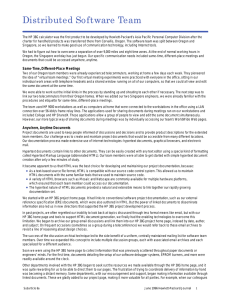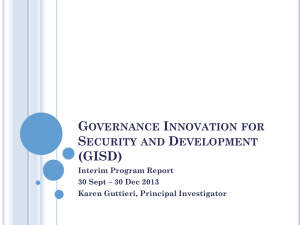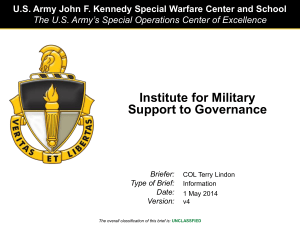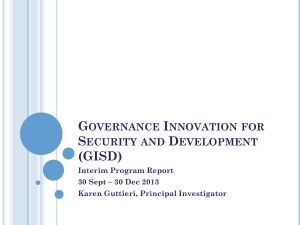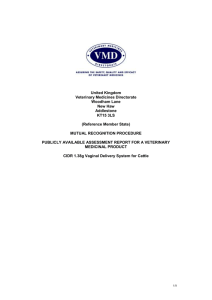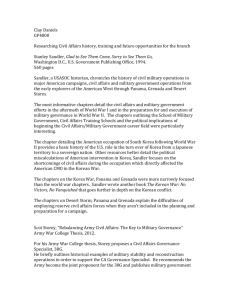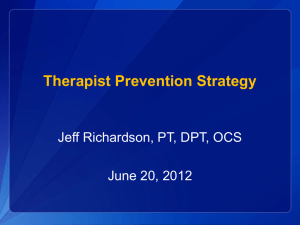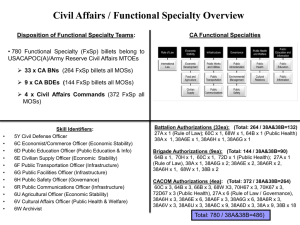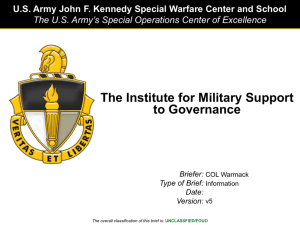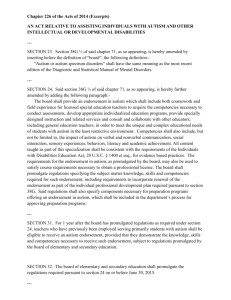GISD IPR SEandSWB Mar2014notes
advertisement
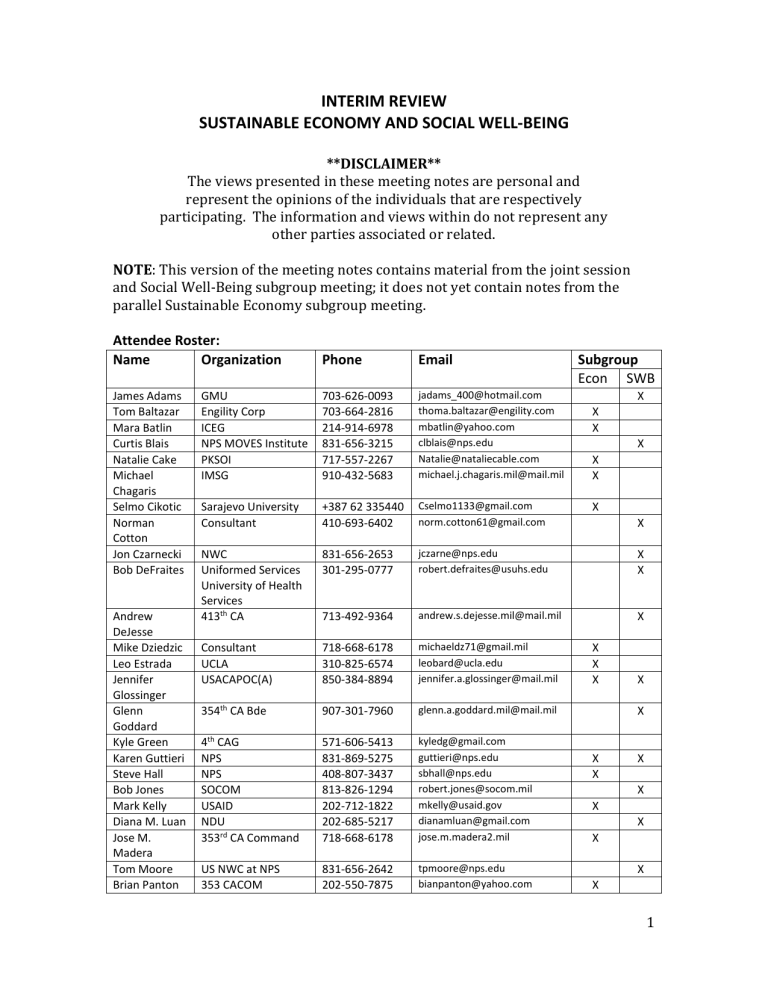
INTERIM REVIEW SUSTAINABLE ECONOMY AND SOCIAL WELL-BEING **DISCLAIMER** The views presented in these meeting notes are personal and represent the opinions of the individuals that are respectively participating. The information and views within do not represent any other parties associated or related. NOTE: This version of the meeting notes contains material from the joint session and Social Well-Being subgroup meeting; it does not yet contain notes from the parallel Sustainable Economy subgroup meeting. Attendee Roster: Name Organization James Adams Tom Baltazar Mara Batlin Curtis Blais Natalie Cake Michael Chagaris Selmo Cikotic Norman Cotton Jon Czarnecki Bob DeFraites Andrew DeJesse Mike Dziedzic Leo Estrada Jennifer Glossinger Glenn Goddard Kyle Green Karen Guttieri Steve Hall Bob Jones Mark Kelly Diana M. Luan Jose M. Madera Tom Moore Brian Panton Phone Email Subgroup Econ SWB GMU Engility Corp ICEG NPS MOVES Institute PKSOI IMSG 703-626-0093 703-664-2816 214-914-6978 831-656-3215 717-557-2267 910-432-5683 jadams_400@hotmail.com thoma.baltazar@engility.com mbatlin@yahoo.com clblais@nps.edu Natalie@nataliecable.com michael.j.chagaris.mil@mail.mil Sarajevo University Consultant +387 62 335440 410-693-6402 Cselmo1133@gmail.com norm.cotton61@gmail.com NWC Uniformed Services University of Health Services 413th CA 831-656-2653 301-295-0777 jczarne@nps.edu robert.defraites@usuhs.edu X X 713-492-9364 andrew.s.dejesse.mil@mail.mil X Consultant UCLA USACAPOC(A) 718-668-6178 310-825-6574 850-384-8894 michaeldz71@gmail.mil leobard@ucla.edu jennifer.a.glossinger@mail.mil 354th CA Bde 907-301-7960 glenn.a.goddard.mil@mail.mil 4th CAG NPS NPS SOCOM USAID NDU 353rd CA Command 571-606-5413 831-869-5275 408-807-3437 813-826-1294 202-712-1822 202-685-5217 718-668-6178 kyledg@gmail.com guttieri@nps.edu sbhall@nps.edu robert.jones@socom.mil mkelly@usaid.gov dianamluan@gmail.com jose.m.madera2.mil US NWC at NPS 353 CACOM 831-656-2642 202-550-7875 tpmoore@nps.edu bianpanton@yahoo.com X X X X X X X X X X X X X X X X X X X X X X 1 Name Organization Phone Email Maria Pineda Diana Parzik NPS DHA-International Health EBI 202-460-8269 703-863-3354 mdpineda@gmail.com diana.parzik@us.army.mil X 571-308-5845 adpaterson@gmail.com X DoS/HIU G-3 SOD 202-634-0343 703-614-7681 puschuskl@state.gov cameron.s.sellers.mil@mail.mil X X WEINSTITUTE NPS 312-802-7524 949-439-3017 ctucker@weinstitute.org marc.ventresca@sbs.ox.ac.uk X X NPS Smithsonian Consultant Walter Reed National Medical Center 215-353-3902 202-633-5003 +377607930077 910-315-0009 Bravo6@verizon.net wegenerc@si.edu info@willot.com ramey.wilson@usuhs.edu X X Andrew Paterson Karen Puschus Cameron Sellers Chuck Tucker Marc Ventresca Jeffrey Voice Cori Wegener Patrik Willot Ramey Wilson Subgroup Econ SWB X X THURSDAY MARCH 27, 2014, USAID BUILDING, CRYSTAL CITY OPENING PERSPECTIVE (2pm - 3:30pm) 14:-14:15 Welcome LTC Linden – Welcome and Project Overview: Establishment of Institute for Military Support to Governance (IMSG); new 38G position in Army CA – to address recognized lack of ability to influence governance What skills are needed – previously conducted a Rule of Law workshop to identify certain specialties IMSG – CAPOC – SWC Want to address how to address Sustainable Economy and Social Well Being (SWB) Oct 2015 – 580 positions in Army Reserve reclassify to 38G (out of about 11,000 CA officers) Tiered approach to provide mobility/growth in the position Karen Guttieri – Governance Innovation for Security and Development (GISD) project (see intro slideset) 14:15-14:30 Plan for the Interim review – seeking outputs defining position requirements of 38G OVERVIEW OF DRAFT KNOWLEDGE BUILDING BLOCKS – how different approaches can inform the process - Testimonials from the Field - [CA professionals, partner agencies]: "What expertise / 2 training especially useful or were you missing?" - Col Madera – perspectives – what is a good expert who happens to be a good integrator able to interlocute. Maybe trying to create a hybrid of skillsets – what has worked in the past and new thinking. - What has not worked – centralized databases for talent, accession (sp) requirements - Not just the way the Army works but how it puts people into certain bins – other competing priorities - Leo Estrada, UCLA Luskin School of Public Affairs: Changing PhD Level Training: A UCLA Case Study (see slideset) – perspective on dynamics of education - Re curricular reform - Training for new skills needed – pure research, applied research, combination - 4 years to accomplish the change - Scientific research is increasingly interdisciplinary; department structure working against interdisciplinary efforts - BioSciences – across several schools/departments - Created consortium of PhD programs to facilitate improvements in curriculum (with more specialized courses), increased faculty involvement, increased interdepartmental grant seeking, increased shared laboratory project, student training that is more relevant, administrative functions - Issues to resolve – how to give up their doctoral degree programs, how to create a joint College of Letters and Science and Medical School degree, how to integrate faculties from 10 departments, how to provide services to students - Consortium of Doctoral Programs – have departments to abandon or make their PhD programs dormant; home areas, multi-dimensional and focused – faculty from all former departments choose to join 1-3 home areas; significant number (7) of core faculty needed to establish a home area; students have flexibility to move between home areas; one year core class created for all students; specialization for students related to lab experience1 - Home Areas: biochemistry, biophysics, and structural biology; cell and development biology; etc – knowledge, skill, specialty - Home areas gave faculty a place to “land” - Defined roles across home areas, MBIDP, and Medical School (individual or shared) for activities (recruit/admit, advise, curriculum, seminars, career counseling, diversity/outreach, grant/funding support, tracking and evaluation, finances) - New arrangement – curriculum enhanced with faculty teaching in the College and Medical School; home areas broke down department silos; students are encouraged to select more than one home area; departments will not “disappear” as they are needed for university organizational reasons (hiring, 1 Possible to have CA self-organize their profession? 3 - - - - - - promotion processes, etc.) but their functions are greatly reduced Home areas are a better reflection of the current state of research activity in the biosciences; other science areas are looking at BioScience as a model and may soon follow (Earth Sciences and Atmospheric Sciences); other social science areas admire the model but are reluctant (more territorial; nothing culturally pushing them together); innovation in training doctoral students represents a new way to find biological solutions for the future Faculty buy-in to home area idea (ownership); letting the faculty home areas rule themselves Seeks greater relevance for the field Entering experimental stage CA context – need to shift to a different kind of thinking / paradigm shift – how do people feel about the “goodness” of governance Home areas – like fields in a department; Russia – very specialized (departments are fields) – home areas are intended to be more flexible than a “field” – built more around research activity than knowledge Change in student population? When designed, amount of interest in the program increased by 80% Who gives tenure? Home area. Degree? Home area based. Will this result in better research / better biologists / better doctors? May take years to determine. Marketplace driven changes (put out cheaper product, create greater accountability for research dollars) – comment about PhD in Economics having no practical value (Patrik) Company restructuring – what was needed at the end – in this case, students who would meet market requirements for bioscience. For 38G, clients are the various governments – what do those people need? What are the functions the 38G will perform? Not job description, but what is the added value? What attributes describe the functions? Then design curriculum or draw from pool already existing in Army or society. (Tom) Inertia applies to humans and organizations. What external force(s) overcame the inertia? At UCLA, knew something was wrong because the number of PhD students was declining dramatically. The way NSF was giving out funding in biosciences changed (had to work cross-department). This was a solution to do the job better. (Andy) Do we also have to address incentives? Are there different kinds of incentives DoD can put on the table (e.g., tax-free overseas salary)? How to pull in the people with the right training – what’s the incentive package to bring them in? 14:30-15:30 Understanding the Complex Adaptive Nature of Nation/State Building – Steve Hall (see slideset) Model-building; one way to break down stovepipes, how things interact Guiding principles – “Guidance for the provision of essential services providing 4 security, the rule of law, economic governance, and basic human needs are interdependent priorities.” Idealism (meaning) <-> Materialism (survival) versus Persistence (knowing) <-> Adaptation (believing) Donor conception of inter-state relation value determines how they engage (and how they will measure success) SSE – SWB – Sustainable Economy: positive feedback between the emerging conditions dominates… and the nation and state spiral upward together Important consideration, whether this is a closed system or an open system Opposite conditions can occur – positive feedback between the disintegrating conditions dominates and the nation and state spiral downward together Each objective is uniquely complex, consider SWB – there are context sensitive conditions Many tradeoffs described in the literature across the sectors – many donor actions have context sensitive impacts on the direction state building will go How do we start modeling this? Introduction to System Dynamics modeling (stocks, flows, influences/variables) Sample macro causal loop diagram of state constitutive capacity (Enos and Far, “State Security Dynamics and the Impact of Intervention to Build Country Capacity”) Sample model: Security Sector (Choucri, “Understanding Modeling State Stability: Exploiting Systems Dynamics”) Sample model: Economic Sector (Sterman, “Business Dynamics: Systems Thinking and Modeling for a Complex World”) Modeling process itself provides insights Understanding complex Adaptive Systems – show interactions between the parts (i.e., feedback loops); generate the complex emergent group behavior we see from the simple constituent agent behaviors that we understand; … Key “Agents” of a Nation State Development Model – individual agents (passive and politically relevant – “what will I sacrifice in order to protect”); social networks (host state, sub-stage SIGs, donor states, NGOs – networks of people who share values); environment (politically passive backbone of goods/service delivery) Economically rational, self-optimizers (rational self-interest) with desire to interact with the “other” (willing to spend resources to have relationships with “other”) Early Concept of 38G Nation State Building Training Tool – recognizing trade-offs and influences across sectors Identifying 38G specializations and required competencies – how should they be identifies, what should performance requirements be, how would the 38G generalist coordinate efforts – how does this system dynamic modeling effort support this objective? Model can facilitate thinking of this problem as a system engineering task 5 (Tom) How many have seen systems dynamics process before today? Not many. Influence diagram can be a useful method moving forward for better understanding the world of the 38G. (Jon) Systems dynamics model for re-engineering US Army – significant costs. High-level – illustrative, informative. Detailed modeling – very high cost to develop powerful tool. Goal for project is to create a conceptual framework for the work. Marc Ventresca – lead for Social Well-Being (SWB) Sector Systems thinking perhaps in contrast to the 14 CA functional specialties – want to think about interfaces, integration (know-how, not know-what) [BREAK] 15:30-16:30 Work groups OVERVIEW OF DRAFT KNOWLEDGE BUILDING BLOCKS, PROBLEM FINDING, GAP ANALYSIS - Testimonials from the Field - [CA professionals, partner agencies]: "What expertise / training especially useful or were you missing?" - Discussion of key gaps in expertise Parallel Tracks: [1] Sustainable Economy 1. Macro stabilization (monetary and fiscal plan, banking regulation) 2. Private sector (investment, production and markets; infrastructure development) 3. Employment generation (agriculture production and growth) 4. Illicit economy (Control of resources, contraband, of combatants) Success? Enable our CA soldiers to know/practice appropriate economics to succeed in their mission. knowledge backpack strategy – knowledge – awareness (strategic awareness) advise/consult 38As and Ministries What are functions: Product, Trade, Finance across dimensions of (1) education and generic experience and (2) critical relevant experience Transactions, trade-offs, risks, added value Defining attributes/characteristics of 38G individuals – well educated, military background, temperament (EI) What is relation between security and economics? Flexible principles of organization is essential Communication capacity of personnel is to be emphasized – hearing/listening; emotional intelligence; transitional mindset developed 6 Must understand informal economic sector Needs to be adaptable What are the dysfunctions? Problem is informal economy – illicit? Problem is political economy Don’t really want PhD economists Where/what level of intervention Must be sustainable, by Host Nation Need to know what is driving strategic leader [2] Humanitarian Assistance and Social Well-Being 1. Sector focuses on basic needs such as food distribution, housing refugees and displaced persons, and providing sanitation. 2. Long-term social well-being development in programs such as education and public health ensure host nation government can develop citizen abilities to provide for their own welfare, which further sustains stability Marc started the session with introductions around the group: - Glenn Goddard, CA Brigade commander - Jim Adams, Sr ops officer, coordinating refugee; CA in Kosovo with UN, affairs of minorities; governance officer; PhD at GMU in Conflict Analysis and Resolution - Bob Jones, ret SpecOps Colonel, J5 Strategy & Vision; law school, prosecutor; SOCOM – about 9 years ago drilled into what this dynamic is about, systems in conflict - Tom Moore, NWC at NPS; ret Army Col; G-1 and G-4; Water Board - Diana Parzik, health policy, Global Health Engagement, med service, environmental science officer, disaster preparedness, CA Co commander - Norm Cotton, ret CA Col, joint/strategic level; security sector reform advisor; stakeholder analysis for the GISD project - Andrew DeJesse, CA officer; community subgovernance level - Chuck Tucker, ret MGen USAF, JAG; Somalia, Bosnia, Kosovo, Afghan, Iraq; running capacity development efforts overseas - Karen Guttieri, NPS; public policy; international and domestic, civil-military - LTC Jeff Voice, CA officer; NPS SSDCO graduate; 38A officer plans team chief – Bosnia, Iraq; CA since late 80’s - Curt Blais, NPS MOVES Institute – project management support, modeling What is current problem in the space and what 38G is trying to solve? Current incapacity? What is 38G trying to solve? Number of people living in large urban environments, gender roles – as 38A exposed to public health but nothing on urban planning; population-centric conflicts – gap 7 Another one filled by human terrain teams (HTTs) is idea of mapping the human environment; CA could not grow to fill it – should it now be moved into CA structure? Seems more appropriate to CA than to Intel. New models across agencies – how does that affect CA thinking? Move from function-driven expertise to some other level of expertise. Space-time-forces – understanding the operational environment. Does 38G need to turn into his own intel apparatus? Need to keep CA and Intel distinct for political reasons. G-2 informs targeting. Every HTT was used differently depending on who employed them. Fill void of HTT going away by bringing in geo-mapping expertise/practitioner. Intel apparatus collects information – do we say don’t bother to collect information relevant to CA, the CA team will do that? Need to keep Intel out of the picture. Intel will collect, CA will have access to it. What are other gaps? Planning – phase of the engagement. Preservationists, archivists – put into safe and secure environment – by international law, have to protect cultural sites. 38G needs to be able to advise planning. Intel not good at telling you what business plan is needed to establish capacity, just what to take down. Where do we put our resources? SpecOps – understanding influences and relationships. Intel community deals with threats, but have significant analytical capability; can’t get them to understand the soft things. How does CA affairs dealing with governance to tap into the Intel data? UN perspective – sectors generally include Governance, Justice, Economy, Social Welfare. Humanitarian affairs officers, civil affairs officers (administration of the institutions – 38A equivalency; 38G more equivalent to guiding/higher level personnel, directors), political affairs officers (policy interactions with the leadership), military affairs officers. P1 (entry level management – administration, functional responsibilities), up to P5 level of professionalism Conventional force, how it does COIN – confuse ways as ends. If we build these systems and functions, the sum will achieve the ends. In these environments, the ends reside in perceptions. Understanding the population, what their current perceptions are, how to influence and assess perceptions over time. Who thinks about these things in the CA community today – do the 14 functional areas add up to a functional society? Nobody has the systemic view. USCAPOC worried about training management of soldiers right now. Unless you have a forward-thinking CACOM commander, it does not happen. What does that kind of person do? CoG – CACOM commanders. Where do we intervene so 38G becomes integrated, not an appendage. Have to work interagency. CACOMs are rarely deployed. Combatant Commanders need to be thinking this way – needs 38G advice/assessment. Not military problems, policy problems. Engagement will be problematic. Talking about a mindset – even though CA officers are not in charge, need mindset that 8 they are doing a function to shape perceptions to bring population into the fold. Where to apply the capability to establish legitimacy of the host nation. What we do is trying to influence perceptions. Who tries to balance allocation of resources across the sectors to maximize effects? 38G who live and breathe these actions every day are what is missing. Cannot create a 38G super-CA person. How to put together a team that has the right kind of thinking and skill sets? 38A work with IMSG and CAPOC to identify who is needed. What types of projects – health affairs are 50% of project funds. AFRICOM did not have any relation with South Africa until we did a Medical Civic Action Project (MEDCAPS). Same with Azerbaijan. Disaster relief has opened doors for these relationships. USS Comfort Pacific Partnership projects (through US mission to host nation). Medical, dental, and veterinary. One of 6 lines of engagement is Global Health Engagement. Needs to be a focus of CA. Navy has jockeyed for position, not recognized by Army AMED. It’s not the disaster relief we do, but gaining entry to enable greater engagement. Need to do the mission to promote the host nation. Jennifer – in Ethiopia, medic could not do CA type stuff. Maybe do a global health certificate in the future. Don’t forget about cultural heritage. Governance and big operations – don’t forget about the parts of CA that are to keep us out of international legal issues (don’t strike zones, etc.). GIS planning/mapping. Need to respect cultural memory. Trust / good will – hard to build, easy to lose. Bounding strategic and tactical – could more easily accomplish low-level projects, but now need to address broader issues with fewer assets Winning hearts and minds – building trust. Hard to do structural construction projects to meet human value problems. 38G can bridge that gap. Have to map this out as simply as possible – use the guiding principles – look at the conditions of SWB and identify the areas. Pull out the relevant Additional Skill Identifiers (ASIs). Maybe talk a bit more about center of gravity in relation to this Integration gap – 38G need know more than specific skills – where and when to perform a project and how to find the right agent to do the project Skill gap -- how to find these folks and convince them to join the Army Conflict transformation perception If 38G is functional expert, need to identify the ASIs to assign. What do we do to take a collection of them, training wise, and get them to work with the other agents to learn how to perform their tasks. Dwell time and ops tempo – impacts ability to provide the right people for the right jobs at the right time. How to retain the folks. Rotation / job sharing, constantly communicating with each other. Connectivity gap. [Jeff’s diagram below] 9 In Iraq, important to win hearts and minds? No, important for Iraqi government to win hearts and minds. Many of the CA projects were perceived as “just don’t kill us”. Planners need to be working at the top to identify where assets/resources can be spent and accomplish something. How to promote and secure our vital interests? Not thinking about all of it combined to shape to desired ends. Phase 1, 3 implications, what level (tactical, operational). How to incentivize a civilian? When out of the field, they are losing money. Typically join because of passion. Give them real-world experiences that enhance their civilian resume. Do short-term assignments. Civilians don’t care about going to battle assembly but giving them valuable real-world experiences. “Thinking that created the problem is unlikely to solve it.” (Einstein) Content of planning and execution based on human nature context. People like seeing immediate results -- don’t just do the easy jobs because we can. Better the right thing poorly than the wrong thing well. Look at State Partnership Plan (60+ countries around the world – no CA involvement). White board: - human terrain “map” gap - influence gap – OPLAN <- analysis (data points) - urban planning gap - integration gap - skill gap - relief to development - experts (e.g., med) don’t know CA 10 - parts of CA that keep us out of trouble with international law are important - social well-being - conflict transformation perception gap - connectivity gap (community of practice) -- civilian job / military job rotation - “Thinking that created the problem is unlikely to solve it.” (Einstein) Content of planning and execution based on human nature context. People like seeing immediate results -don’t just do the easy jobs because we can. “these are the things that define a failed state” 11 FRIDAY MARCH 28, 2014 Sustainable Economy Sub-Group 9:00-10:00 OUTBRIEF from Day 1 10:00- 10:30 SPEAKERS FROM THE FIELD Dr. Hilton L. Root / Amb. Klauslerich (Invited) Discussion of inter-dependencies Discussion of key gaps in expertise System viewpoint Interaction with Field Operative 10:30-10.45 – BREAK 10:45-12:00 GAP ANALYSIS Humanitarian Assistance / Social Well-Being Sub-Group 9:00 – 10:30 GAP ANALYSIS Discussion of inter-dependencies with partner agencies Assessment of key gaps in expertise Substantive functional knowledge: ‘know what’, in contrast to ‘know how’ Lessons from field experience Lessons from research on large-scale ‘technology’, infrastructure systems - Traditional functional silos/boxes are relatively less effectiveness at being supple Next 10 years, CA tasks will look considerably different than past 10 years – can’t keep doing what we’ve been doing. Challenge is to push the boundary of the language. How to turn these into something useful for LTC Linden – descriptors, skills, and levels (but not recreating the 14 functional specialties in more elaborate form) Series of functional specialties – HA, water, health, sanitation, … -- with specific skills, levels. Patterned after findings of RoL sector review. Maybe not skill levels by substantive function, but set of descriptors for process skills based on stakeholders/partners. (don’t need specialists, need integrators) What also is the role of 38A (assess and build teams of experts; team leader) in light of emerging 38G (expert and integrator)? 12 - - - - - - IMSG is not the holder of the 38Gs – they are embedded at COCOM levels. May need greater discussion – IMSG may also hold a stable of experts who can be called upon, assigned. How do the pieces fall out on the battlefield from tactical to strategic? 38G at corps level? Can be called upon by the team leaders? The skills/capabilities are what matters – will be packaged according to mission requirements. Bring closer to support governance efforts at provincial level. Commanders will decide how to use the blocks. Skills to be defined have to be broad enough to fit the phases and tactical to strategic. CA teams (38As) in 38 countries right now – they are the maneuver element – how do they move around, how do they communicate. Supporting embassies – how to call back for reach back for expertise in a particular area. Future requirement may look like: regionally aligned forces, distributed (smaller teams operating with general guidance), embedded (UAP), expeditionary, taskorganized Recently, mission changed rapidly from HA to security assistance in many countries Commanders identify subject matter skillset needed and pull that person 38Gs shift to substantive knowledge; they have specific expertise 38G will be that one thing, not with specific ASIs (more like JAG and medical specialists) Reach back may be an empty purse – 38G should be strategic, with “street cred” with other agencies – how to get that “street cred”? Experts, with military experience – sounds like a retiree. Need discussion about how to bring the right people in. E.g., re medical, who will have the contacts in WHO? How to put people into places that are career-broadening. Out of synch with new frameworks (e.g., millennium development goals) Jim shared UN framework – country (e.g., Kosovo) – state-region-municipality levels (see diagram below, courtesy of Jim Adams) 13 - - - Re recruiting – why not bring in people from other countries? CA community at tactical level – one BN at 26% of the number it should have – from where will the people come? Special Warfare Command has the training and education piece. Recruiting piece is recognized but being dealt with in a different venue. Here we need to identify what skillsets are needed. What kind of person needs to know about Social Well-Being (issues come out of Geneva). Need to understand the UN system. UN hiring/contracting/logistics systems. Argument for career-broadening assignments – must completely understand the international system. AUSAID, EU/EC will be key players. Need to understand PhD/post-PhD areas of study (e.g., public management department at Indiana University) – puts people in contact with important internationals. Need to plug into international community. UN taxonomy – political affairs officer, humanitarian affairs officer, civil affairs officer, military affairs officer, social well-being affairs officer Had functional skill identifiers, but had no doctrine for how to apply them – that is being developed now How does military support governance – what skills are needed in social well-being to do that? 38G – think of him as a professional staffer, like a Limited Duty Officer – brought in for their civilian skills to have impact on the military planning process 38G is 38A with a strategic ministerial level influence? 38A with value-added expertise? Specialist/Expert/Consultant (38G, advising stakeholder and commander) vs Generalist/Manager (38A, advising commander and ambassador) 14 - - - What are the overlapping skill sets, what are the added skillsets (what distinguishes the 38G)? 38As are in many countries working for the Chief of Mission; they are the maneuver element (own logistics, own force protection, etc.) – providing extra capacity to AID, State, UN. “New CA officer is community affairs officer with a gun.” CA does various tasks (medap, drilling well); must be commander/manager of CA people doing things; needs to be a staff person advising ambassador, conventional commander, host nation ministry – 38A has to do all of these – where is division of labor for 38A and 38G? How to affect security factors at the strategic/national level? How fine-grained should be the distinctions across 38Gs Pre-conflict through Phase 5 – too broad. Concentrate on pre-conflict and end of conflict. Environmental science officers have public health / social medicine backgrounds What credentials are needed in areas like health, education, refugees, IDPs, etc.? Cross-cutting – demographic mapping Skill set: - “street cred” - understand other frameworks (UN, WHO, …) – external stakeholders (will be operationalized through demand signal from external agencies) - know capability of partner/stakeholders - career broadening assignments part of life-cycle for MOS Social Well-Being - [UN] health, education, social welfare, refugees, IDPs, civic participation, community development – what broad skillsets need to be brought into the mix - Cultural security - Religious security - Commo security - Environmental security SWB Breakout Groups: Health, Refugees, Large-Scale Infrastructure Projects What can we learn from available models? What specific expertise is required? [1] Health – Diana Parzik What can we learn from available models? Army – 72A Radiation; 72B Entomol; 72D Environmental Service Officer (food handling, industrial hygiene); 72E Engineering (BS Engineering); Nursing 66 Public Health Nursing; Physicians 60C PM; 60D OM, 61N aerospace; Hospital Admin 70A; Med Ops/planner; animal health; food source inspection Models – Special Medical Augmentation Respoinse Team; Socio-cultural Research Adversary Team; Special MAGs (Military Assistance Group?) in Horn of Africa 15 What specific expertise is required? Med / Health / Public Health / environment Global Health Specialists / International Health – Ethics, Legal, Global Public Health; Disaster/ Emergency Response; Culture; Health Services; Language 38G Public Health – (BS PH, M PH, MS PH, Dr PH) - water and sanitation - food sanitation (nutrition/malnutrition) - health systems – admin; emergency fire; hospital capability; public health governance; facilities; clinics; personnel manning (#mds / #nurses / #technicians); health culture; planning; financing Work Experience – medical director (state/county/national); health federal agencies Civ capability exp + training & education in CA + international experience + HELP, MSOC cert programs LNO with health agencies; engagement Degree (M PH, MS PH, Dr PH, etc.) Rebuild/reconstruct health care in post-conflict – need much higher level strategic effort Same expertise, different use (more planning/execution) Any generic skills? MS in Public Health (systems-thinking), maybe with International Health emphasis. Explosion in Global Health programs in last 5 years. Undergrad programs are very new. Maybe with certificate in complex emergency JHU – health emergencies in large populations; USIP post conflict health course; global health diplomacy course Public Health Services and CDC have some footprint overseas (e.g., disease surveillance, research) Money and MOA, maybe don’t need so many 38G but could reach back to pull from domestic public health services Not just emergency responder, but planner/developer Civil Defense Officer (FEMA mode) – don’t know if this will be retained [2] Refugee/IDPs (vulnerable populations) – Jim Adams - Cultural and identity groups - Religious groups - Former combatants (DDR) - Gender/children What can we learn from available models (prior experience / frameworks)? - functions: protection, normalization, and empowerment 16 - tasks (some overlap with other sectors): jobs (re discrimination), freedom of movement (RoL), food/water, shelter/housing, medical, return/reintegration conditions (RoL; human/civil/civic rights), security (SSE) What specific expertise is required? - Complex emergency responders – logisticians (understand complex emergencies) - Minority affairs (protection) – governance and cultural dynamics; fairness factor - Emergency medical services (assess and coordinate) - Demography – understanding demographics and population migration, mapping needs - Business administration? - Understanding interplay of this area with other areas of SWB and the other sectors - Coordination with civil-military - Relief-to-development continuum advisor (integrator) - City management / urban planning - Conflict analysis and peacebuilding - Contracting - Utility advisor Education: certificate programs (e.g., at USIP – complex emergency management, with sector specialities wrt return & reintegration, health, food/agriculture; medical management; demobilization/reintegration of combatants) - Bachelor – no requirement - Master – peacekeeping policy, peacekeeping management, conflict analysis and intervention [broad areas – would need to specify specific coursework] - PhD – peacekeeping policy, peacekeeping management, conflict analysis and peacebuilding, peace and conflict studies 38A – generalist; mission sets: civil information management, population resource control (assessments), nation assistance (advising; OCONUS)), support to civil authority (US), humanitarian assistance / disaster relief - some now have Additional Skill Identifiers (14), but difficulty filling those 38G – specific expertise Maybe can achieve much of this by refining the CA Civil Defense officer – lean this part toward disaster preparedness (can impact security support) and management. [3] Large-Scale Systems (Infrastructure Projects) – Glenn Goddard (see 38G Essential Services document in SWB tab on APAN; also inserted below) 38G: Essential Services and Infrastructure There are four essential services areas: Potable water and wastewater systems (new ASI needed) Communications systems (6R) Electricity, natural gas and other power systems (new ASI needed) 17 Transportation systems (roads, bridges, airports, seaports and logistics systems) (replaces 6G and 6F). Required Expertise: For proficiency code 1L: Knowledge of and expertise in the technical aspects of the planning, construction, maintenance and management of at least one of the four essential service and infrastructure areas. Ability to assist local host nation government authorities with management, maintenance and/or restoration of the type of local essential service mentioned above. For proficiency code 1M: Proficiency at level 1L. Knowledge of project management; Knowledge of essential services and infrastructure in at least one foreign nation. Ability to advise U.S. military leaders and local and provincial authorities regarding management, maintenance and/or restoration of the type of local essential service for which the officer has expertise. For proficiency code 1N: Proficiency at level 1M. Experience managing a significant infrastructure project. Knowledge of and expertise with at least two of the essential services and related infrastructure. Ability to advise U.S. military leaders and provincial host nation authorities regarding management, maintenance and/or restoration of two or more types of local essential service areas. For proficiency code 1P: Proficiency at level 1N; Ability to advise host nation authorities regarding any essential service (and related infrastructure) that is owned, maintained, managed or regulated by the host nation government. Rank Qualifications O3 Undergrad degree in project or engineering management or an engineering field related to one of the four essential service areas (see list of possible engineering degrees below) O4 + EIT or similar certification or equivalent experience + overseas experience O5 + Masters degree in project management or an engineering field or P.E. or equivalent experience O6 + Ph.D. in an engineering field or significant program management 18 experience or Masters degree in project management; plus significant overseas experience *Qualifying engineering fields for entry level 38G—Essential services: Civil Electrical Mechanical Industrial Logistics Systems Engineering management Geotechnical Aerospace Environmental Agricultural Manufacturing Production What can we learn from available models? Qualifying engineering fields: civil, electrical, mechanical, industrial, logistics, systems, engineering management, geotechnical, aerospace, environmental, agricultural, manufacturing, production Public Works officer – project manager to bring in expertise to address needs of overall system. 38A should be the project manager (generalist, broad picture, trying to achieve a defined mission). Experts are the 38Gs. At another level, can have Program Manager, with multiple projects under multiple project managers – knows interrelationships, multiple systems. How broad should a 38G become as he rises in rank (higher education, higher experience, higher certification). E.g., Reconstruction Management Office in Iraq. What specific expertise is required? Project Management – PMP certification Defined bona fides -------LTC Linden – provided printouts of CA/Functional Specialty Overview (see handout set) Proponent – Spec Warfare Center and School Can do minor change to existing designation easily, if one already fits. Ultimately, need to give a job title with description of position(s) and qualifications. 19 -------Recommendations on Social Well-Being 38G Positions, Skillsets, and Tiers (basic, senior, expert, master) 1. [Position] - Description: - Experience and skills: - Primary: - Supplementary skills and experience: - Preferred: - Proficiency Code: [for each of the tiers/levels] - Qualifications: - Supplementary skills and experience: 13:30-16:00 WORKGROUPS HUDDLE Discussion on determination of background and credentials needed for 38G Work in small work groups Social Well-Being definition of new positions / new positions (new) Global Public Health Officer Description of positions. Identifies positions requiring assessment and advice on all aspects of health that impact social well-being. Qualifications. -Minimum Master of Public Health, preferable with International or Global health concentration. -Some combination of following: Health Emergencies in Large Populations course (ICRC) Medical Support of Stability Operations (Def Med Readiness Training Center) USIP Post-conflict Health Course State Department Global Health Diplomacy Course Global Health Stability and Security (CDHAM_USUHS) Veterinary Stability Operations Course Medical Culture (CDHAM_USUHS) Refinement of 5Y “Disaster Preparedness and Response Officer” Description of positions: Identifies positions requiring assessment, advice, and analysis of all hazards preparedness and response operations for domestic and international disasters. Qualifications: Master degree in Disasters Management 20 and Some combination of additional courses: Int’l Diploma for Humanitarian Assistance (IDHA) UN C-M Coord Course EMAP Emergency Management Assessment Course (FEMA) Certificate in Emergency Managemnet FEMA Course ICD HAZMAT/HAZWOPER CBRNE Joint Humanitarian Operations Course (OFDA) Complex Emergency Officer (refinement of 5Y) Description of positions. Identifies positions requiring analysis, planning, implementation, and management of indigenous emergency service assets in the preparation for or conduct of civil defense response to complex emergencies. Enables vulnerable populations to progress through protection, normalization, capacity building and empowerment in order to ensure full participation in civil society and governance representation. Qualifications. Requires the completion of Federal Emergency Management Agency (FEMA) independent; or equivalent experience as a Regional Civil Defense Director; or Certification as a Certified Emergency Manager (CEM) through the International Association of Emergency Managers or a degree in Emergency or Disaster Management through an accredited teaching institution. Qualifications. Basic levels (1L) completion of a bachelor’s degree (Major immaterial) and certificated in Complex Emergency Management with 2-3 years of field experience; Advanced Levels (1M-1P) require a Master level education in Peacekeeping Policy / Management, Conflict Analysis and Intervention (Doctorate for 1P) Relief to Development Continuum Officer(new – 5Z) Description of positions. Advises commanders and international or national level leaders and manager or stakeholders and other experts on adequate planning, implementation and management across multiple sectors; integrates to achieve unity of effort across the relief to development continuum in concert with stakeholders. Enables appropriate responses through the phases of (1) complex emergency, (2) stability; (3) normalization; (4) development. Qualifications. Basic level (1L) completion of a bachelor’s degree (Major immaterial) and certificated in Complex Emergency Management with 2-3 years of field experience; Advanced Levels (1M-1P) require a Master level education in Development or in Peacekeeping Policy or Masters in Conflict Analysis and Peace Building. (Doctorate for 1P). Appendix A. APAN Adobe Connect Chat Content 21 Some participants attended portions of the meeting through the APAN Adobe Connect capability in the GISD group on APAN. Content from the Chat window during the proceedings is provided below. James Embrey 2:Hello from PKSOI at Carlisle Karen Guttieri:All views expressed are personal and do not represent those of angecies or other entities James Embrey 2:observation: the measure of the CA officer's success is his/her ability to be conversant and persuasive across organizational cultures - communicate for, and translate effectively back to the commander/command for which they work. James Embrey:My point would be that while the commander may trust you to speak for him, he has to first understand effectively in order to conceptualize guidance to provide to you. Key role you play is to explain to the commander the econ challenges in operational terms/importance, and then to the econ community effectively using the words/concepts that they can understand. the CA officer must be multilingual across organizational cultures, and be respected and heard in both. James Embrey:I did listen in on later part of UCLA, and then on the sim/modeling Karen Guttieri:**All views are personal and not reflective of those of any official positions of agencies.** Karen Guttieri:Dr. Maria Pineda is speaking to her working group on sustainable economic development James Embrey:would also offer that the MPICE, as an adjunct to the guiding principles, would offer some perspectives as well; additionally, the former SCRS Essential task matrix and supporting metrics developed. James Embrey:the measures of performance in conflict environments are useful in the assessments for each of these. The brief that Mike D gave on illicit power structures at SOTEW gave some good insights into the adversary's use/interests in each of these areas - to include revenue generation/denial through corruption and purposeful coercion James Embrey: tangible/physical value as well as virtual/non-tangible value through provisi0oning of supplies/services in exchange for adversary services/preference/favors James Embrey:or is it his/her role to make the case to the commander and senior civil leaders involved that the resources are best placed here not only to increase security, but to set the stage for a stable environ upon which to continue to build? James Embrey:or is the will work/won't work a matter of discussion with USAID, NGO's, and other regionally engaged partners in projects to ensure sustainability over time? James Embrey:the reason I ask this question, is we can too quickly default back to AFG and Iraq experience where our money/resources were the drivers vs future environs where we must partner and share? James Embrey:TSCP efforts can establish initiatives and open doors, but the sustainablity portion to ensure these efforts endure and continue to adde to Host Nation government legitimacy must be factored in through looking past the projects to ensure NGO's, development partners, etc are 22 willing to continue to funds/support until HN can fund / sustain for itself..... 23
